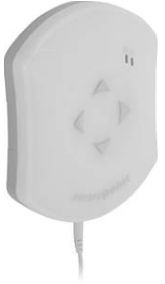Awarepoint has completed testing of its new Bed & Bay sensor that aims to boost the granularity of the company’s ZigBee-based location tracking system for the health-care industry. The device works in conjunction with 2.4 GHz active RFID tags worn by staff members and patients, or attached to assets, and can therefore identify a staff member who enters a specific zone, such as a single bay in a recovery room or emergency room. That data is sent to the back-end system via other types of Awarepoint sensors plugged into outlets that receive and forward RTLS data to a gateway.
The Bed & Bay sensor, which was in development through the latter half of 2012, will be commercially available March 31. The technology was tested for two weeks at three emergency departments in three Christiana Care Health System‘s health-care centers: Christiana Hospital, Wilmington Hospital and the Middletown Free-standing Emergency Department. The three emergency departements, all located in northern Delaware, will permanently deploy the Bed & Bay sensors as part of a full Awarepoint RTLS system.

Most RTLS systems offer a level of location precision that can identify in which room an individual with an RTLS tag is located, or a zone within a large room in some cases. Ultrasound or infrared technology can increase that granularity by emitting an ultrasonic or IR signal that helps identify in closer proximity, exactly where a tag (worn by a staff member or attached to an asset, for example) is located. However, there are still shortcomings in these technologies, says Matt Perkins, Awarepoint CTO. He argues that the orientation of the tag can affect how well it receives or sends ultrasonic or IR transmissions, and that can compromise location data. Some active RFID solutions can provide accuracy within a room but in many cases hospitals have multiple patients located in bays within one room.
Awarepoint provides its aware360 degree RTLS system including software to manage location data that helps improve the efficiency of patient care by tracking when and where patients received what services, based on their location and that of staff. By tracking when a patient was in a specific bed, and when a staff member or piece of equipment was at that specific bed, the hospital could gain data about the patient’s care.
The Bed & Bay sensor emits a ZigBee 2.4 GHz signal (compliant with the IEEE 802.15.4 standard) within a predefined zone and captures tag ID’s within that zone, which can be as small as 1 foot by 1 foot in size. The sensor, with a sticker on the back for mounting, measures 6.2 by 5.2 inches and is 1.4 inches deep. The device is typically mounted on a wall or a headboard fixed to the wall at each patient’s bay, and then plugged into a 120-volt AC wall outlet or a Power Over Ethernet (POE) connection.
When an Awarepoint personnel or asset tag enters the zone defined for a particular Bed & Bay sensor, that sensor reads that tag’s ID, and then transmits its own unique ID, which is then received by the Awarepoint personnel or asset tag. When two bays are located immediately adjacent to each other, Perkins says, the read zone is fairly precise. At most, he says, if the bays are side by side, there could be about six inches of space between two adjacent zones in which a tag might receive signals from each of those zones’ Bed & Bay sensors. If zones were farther apart, that would not be the case.
The Bed & Bay sensor works in concert, says Perkins, with the other types of Awarepoint sensors (specifically, Awarepoint Workflow and Enterprise sensors) that are plugged into outlets and receive and forward read data to the back-end system.
Awarepoint developed the Bed & Bay sensor to improve on location data for its RTLS system, since customers found that they benefitted not just from knowing when patients were in a specific room, and when they were joined by a health-care provider, but also when these actions occurred in rooms with bays.
Although Perkins acknowledges that some other RTLS systems can offer bedside accuracy, he says that the accuracy rate of most RTLS systems is typically around 85 percent. That means, he says, that one out of 10 readings could be wrong, incorrectly identifying the location of a patient, staff member or both. The Bed & Bay sensor, Perkins says, creates “a field encompassing the bay area,” in addition to that, the Awarepoint software also employs an algorithm to confirm that a tag is located in a particular zone, but he says just how that works is proprietary.
The RTLS company conducted a trial of the technology at Christiana Care Health System’s emergency departments at Christiana Hospital, Wilmington Hospital and Middletown Emergency Department. In each facility they installed Bed & Bay sensors in 4-foot-by-4-foot triage areas, side by side. Each triage area was separated by a curtain.
The hospitals also had spaces designated for patients in the hallways, and Awarepoint mounted the Bed & Bay sensors in those hallways as well to create a zone for each bed area. In a third area in each hospital, Awarepoint installed Bed & Bay sensors at standard bays measuring 8 feet by 10 feet and separated by curtains.
Following the two-week trial, the three hospitals will be installing the solution in emergency rooms to be used with the Awarepoint system consisting of tags worn by staff and patients, a gateway to receive the tag and sensor transmissions, and software on the hospital’s management system that tracks the time at which patients met milestones, and when they were visited by physicians. The software also enables end users to set up alerting mechanisms, so that they could receive messages if, for example, a patient had been waiting an excessive length of time for a health-care provider, or an operating room had been vacated and was ready for cleaning.

